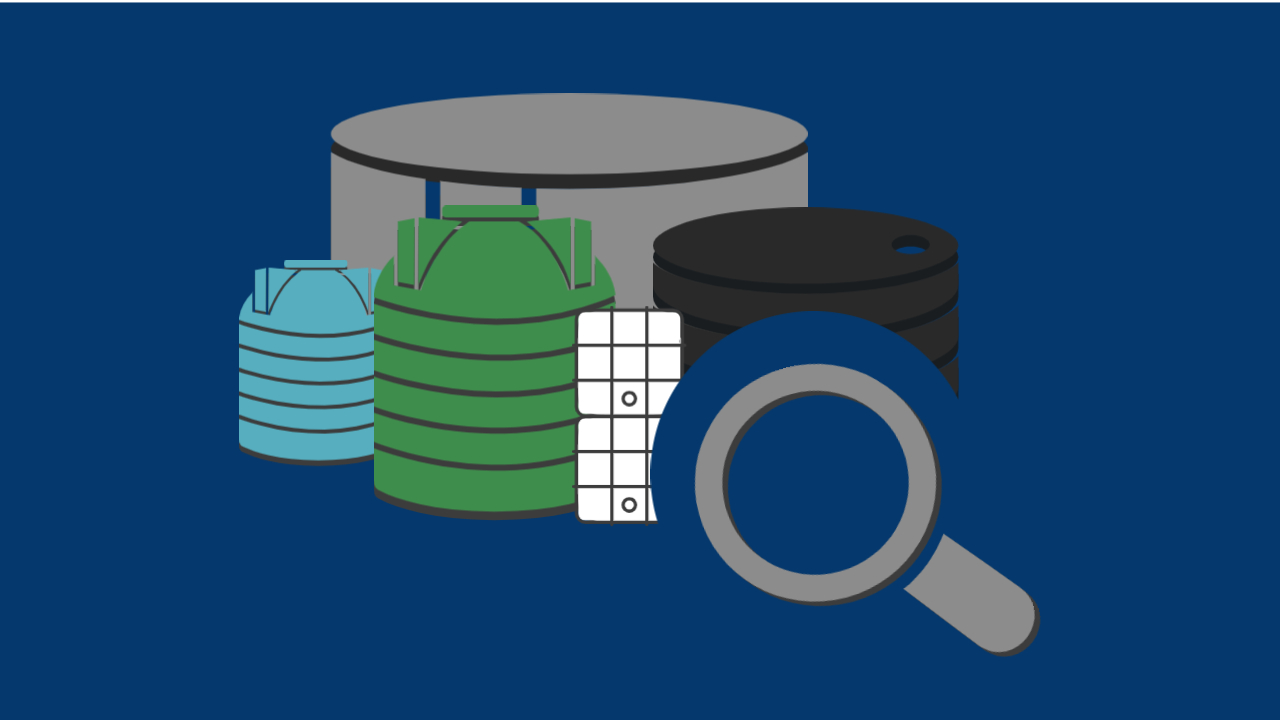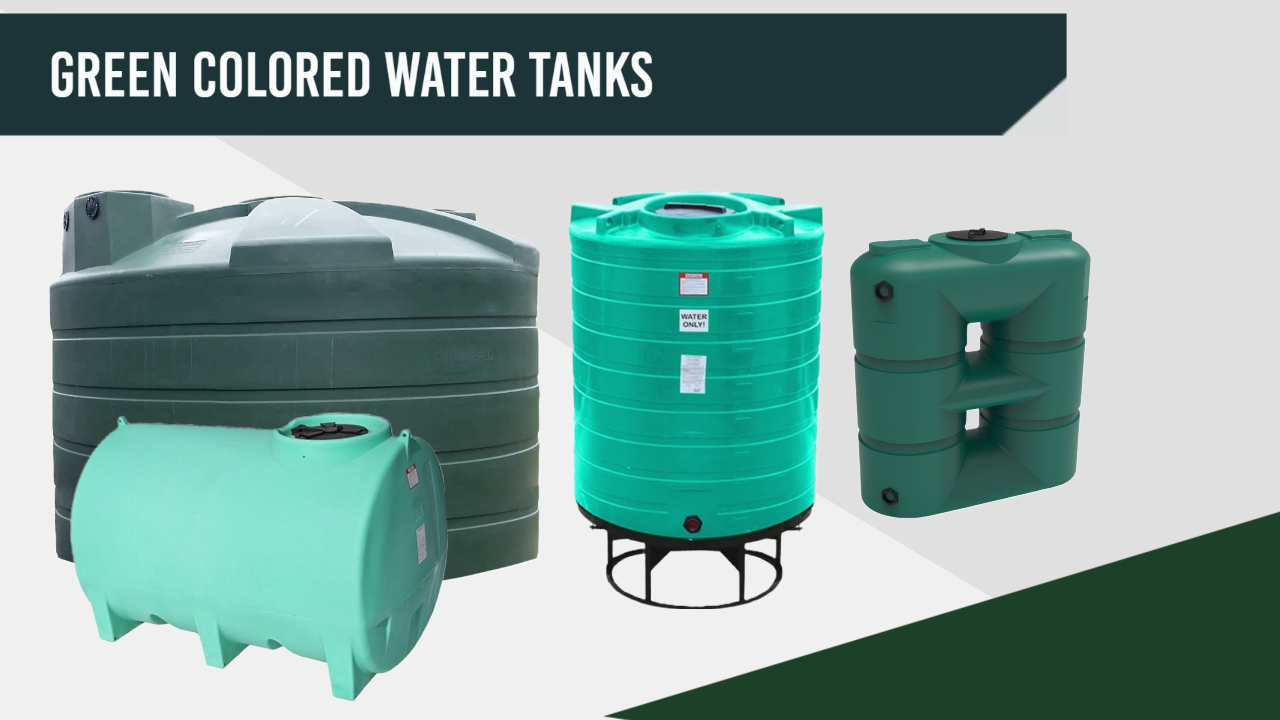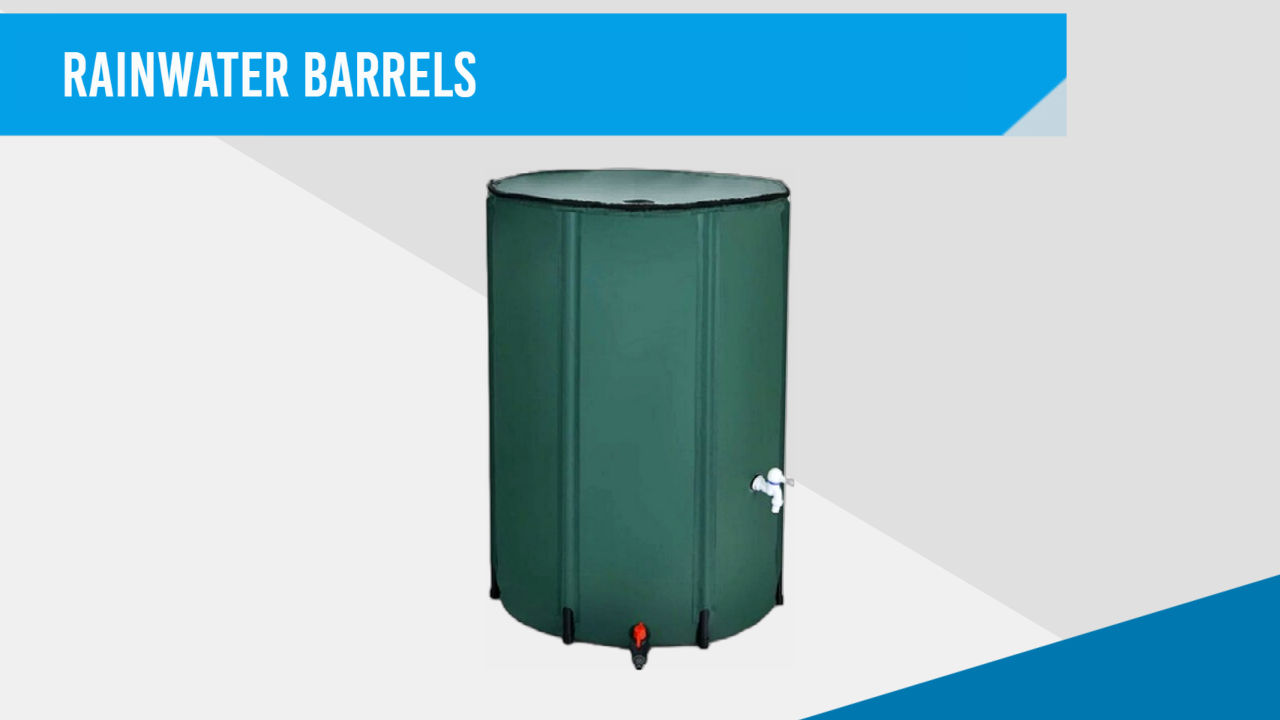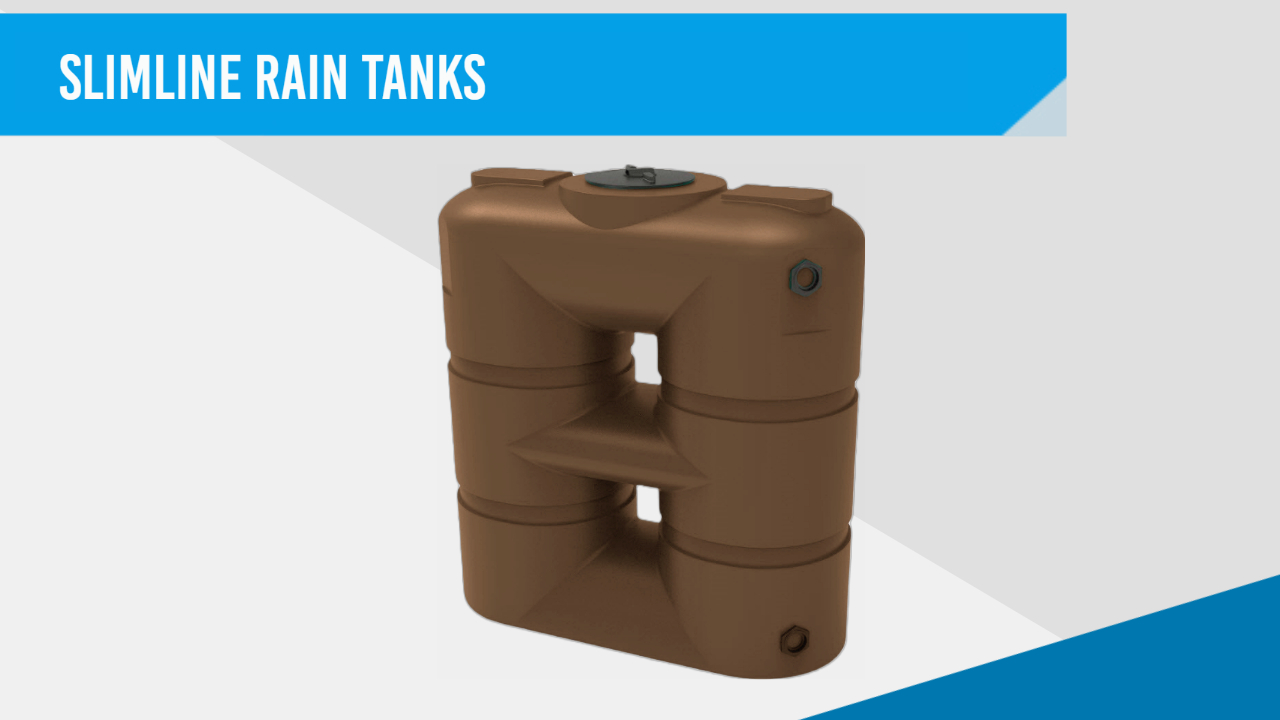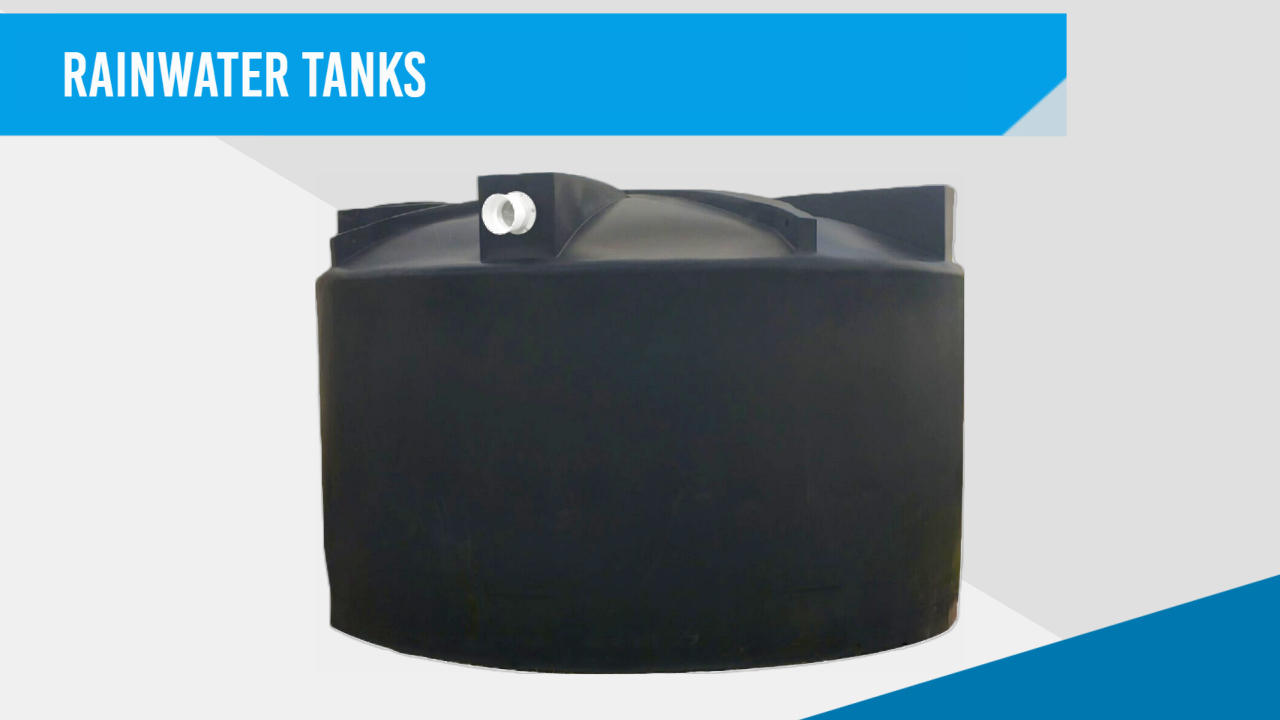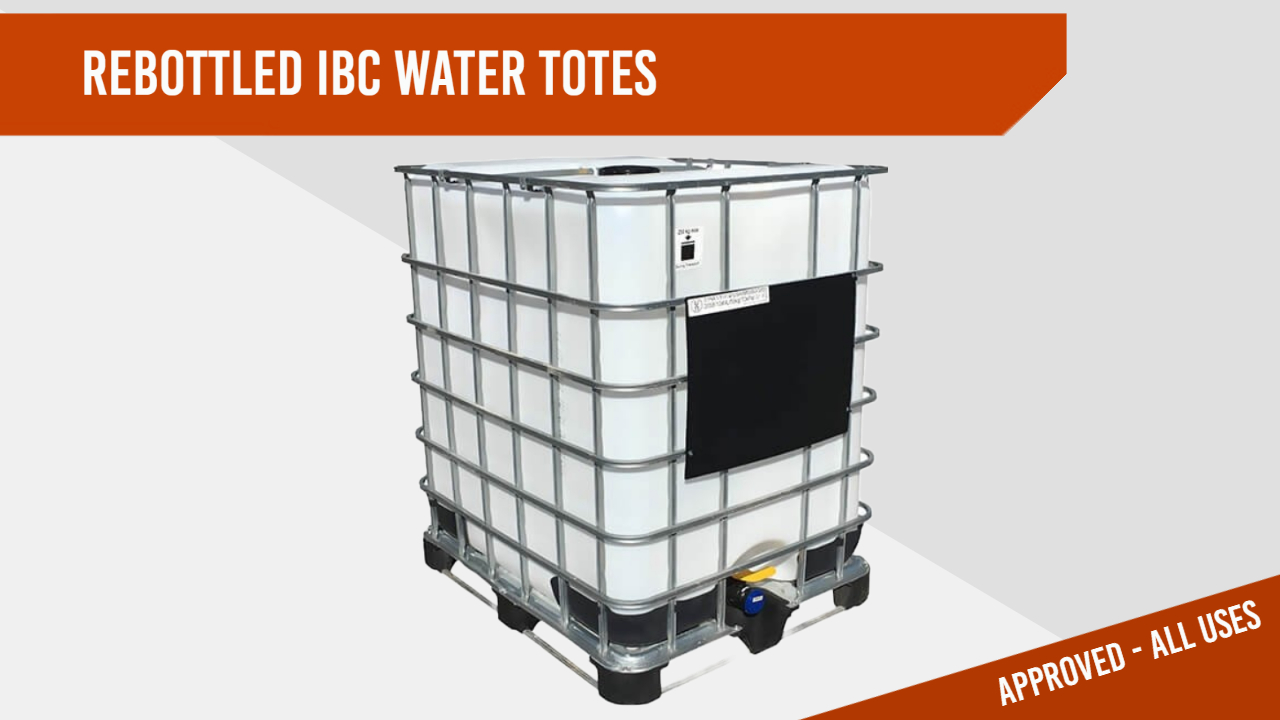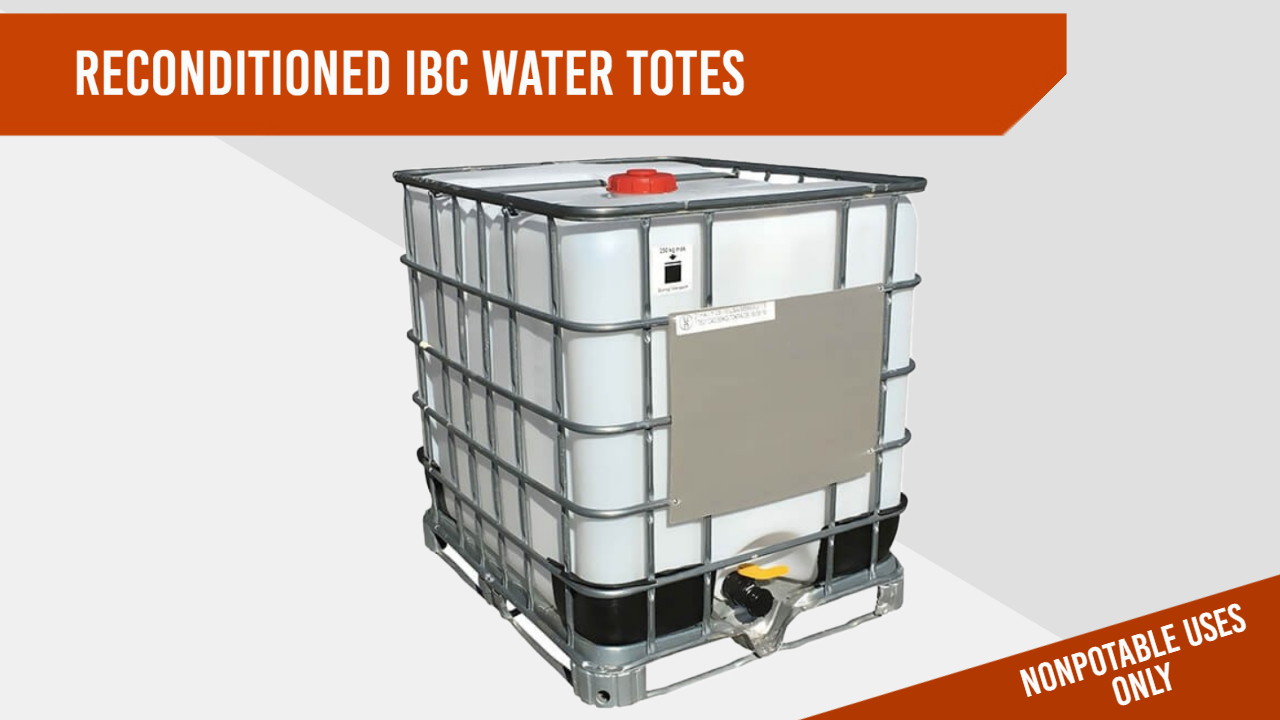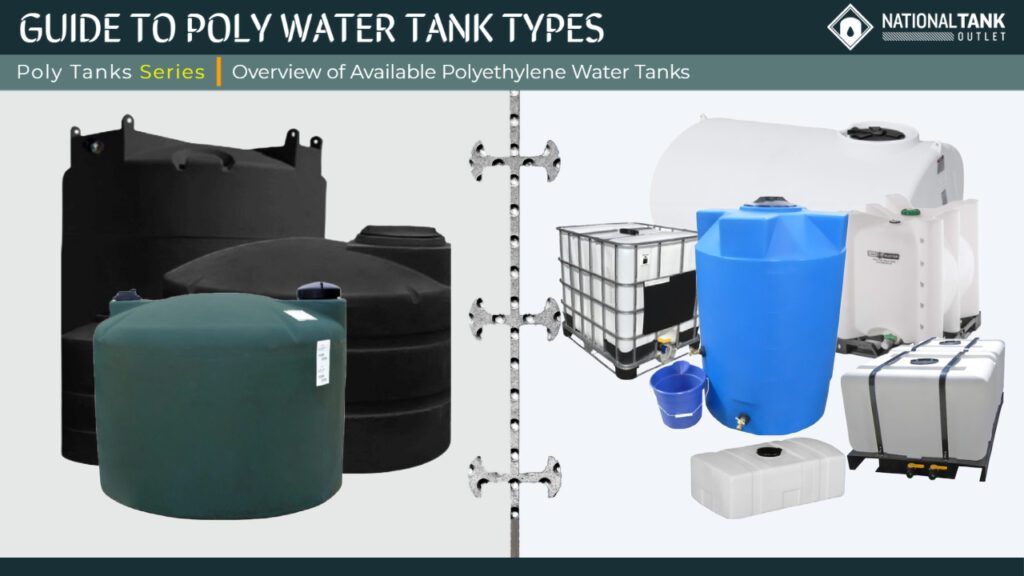
Plastic water tanks are manufactured, engineered, and offered for sale in various tank types, also known as tank style or tank model. The different tank models are intentionally engineered with specific applications and/or work settings in mind. Modern plastic water tanks can also be made from different types of plastic and quality grades.
Water Tank Plastic Types
The most frequently seen and common plastic used to make modern water tanks is polyethylene. More specifically, the type of polyethylene used is known as linear high density polyethylene. High density polyethylene is abbreviated HDPE. Consumer items sometimes have “PE,” “HDPE,” or the number “2” labeled on items made from the plastic. Other plastics sometimes used to make water tanks include polypropylene and fiber-reinforced polymer, also known as fiberglass.
Water Tank Grades
Most plastic water tanks available to buy are manufactured from HDPE but can vary in grade, in manufacturing quality, standards and certification, or thickness. In water tanks, the grade of plastic refers to either potable grade, meaning suitable for drinking water use, or non-potable grade.
Non potable grade water tanks should not be used to hold water intended for human consumption. They are suitable for many other applications such as irrigation and various agriculture, construction, and manufacturing processes that do not require potable water. On the other hand, potable grade water tanks can be used for non-potable water as long as the tank is properly cleaned if it will be subsequently used for potable water.
Most poly water tanks are potable grade quality water container products.
Water Tank Standards
Plastic water tanks that are certified safe for drinking water use are manufactured according to United States Food and Drug Administration (FDA) and Title 21 Code of Federal Regulations (CFR) requirements. These regulations require the use of virgin polyethylene resin that is free of contaminants, harmful or unapproved additives, or chemicals. Virgin polyethylene means the raw plastic material is new, has not been used before, nor does it contain any percentage of recycled material.
The water tank manufacturer, production operations, and therefore the final tank product should also meet the requirements for National Sanitation Foundation (NSF) Standard 61 certification together with guidelines from the American National Standards Institute (ANSI).
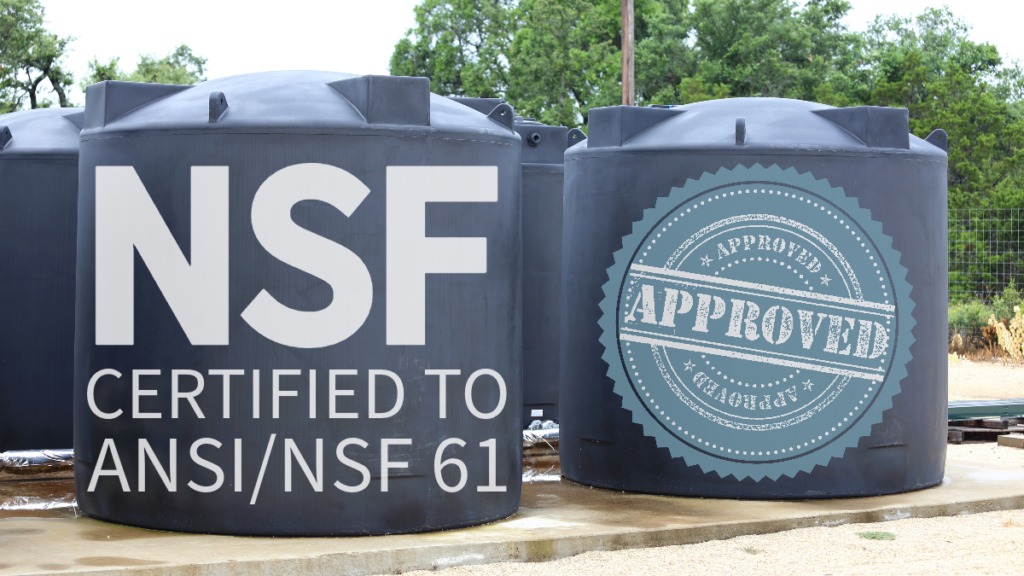
Consumers can rest safe knowing their plastic water tank is reliable and safe for drinking water when the product is ANSI/NSF 61 certified and has been made from FDA approved, Title 21 CFR compliant virgin high density polyethylene.
Overview of Water Tanks by Type
There are eight main water tank types with subcategories or different models within the main water tank category. The eight water tank types are vertical water tanks, underground water tanks, rainwater harvesting tanks, slimline doorway water tanks, portable tanks, utility tanks, IBC tote tanks, and emergency water tanks. Each tank model features a different range of volume capacities, size measurements and dimensions, available tank options, and engineered design to best suit particular applications.
Other plastic water tank types available include cone bottom tanks, truck bed tanks, low profile transport tanks, stock tanks, open top tanks, RV water tanks, and marine vessel water tanks.
Vertical Water Tanks
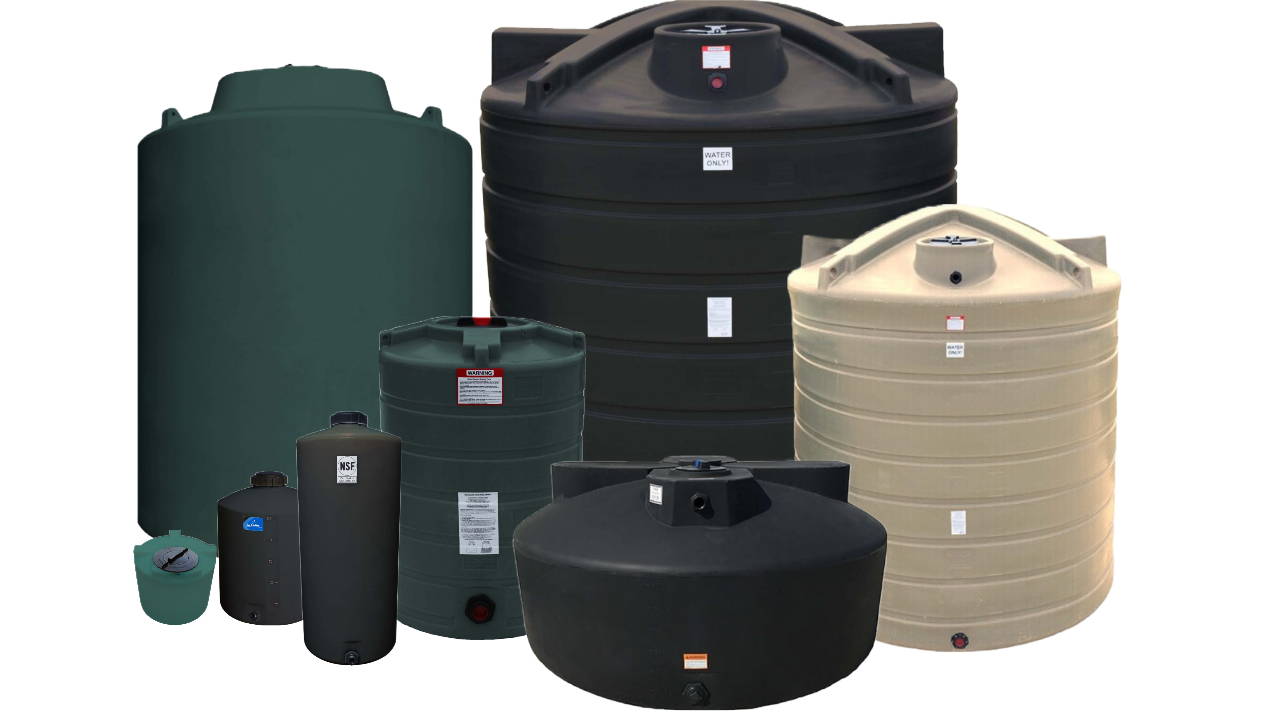
Vertical water tanks are manufactured in storage capacities from 10 gallons up to 20,000 gallons with many volume options to choose from within this range. Purchase costs for vertical water tanks will depend on the tank volume, particular style, manufacturing quality, and whether the tank is potable grade or not. Pricing can range between $80+ to $35,000+.
Uses
Vertical water tanks are ideal for nearly any aboveground application that needs access to a water supply or that is running off water reserves on a permanent or near-permanent basis. Examples include home water supply, well water treatment, groundwater holding tanks, agriculture irrigation, livestock watering, landscaping, fire fighting, and fire protection systems.
The aboveground vertical water tank is not intended for regular transportation and moving from place to place, especially while the tank is holding water, but is designed for stationary installation and use.
Make Color Options
Vertical water tanks are offered with the widest selection of color options between the different water tank types. Vertical water storage tanks can be purchased in either black, green, brown, white, sometimes grey, and sometimes yellow. Some of these color options vary in shade depending on the manufacturer. Most vertical water tanks we offer are potable grade and therefore made in potable grade colors, with fewer options available for non-potable grade colors such as yellow.
Design
Vertical aboveground water storage tanks are cylinder shaped water holding containers with a manway and lid for container access and one or two preset bulkhead fittings for plumbing connections. Vertical water tanks are designed to hold water in a vertical orientation rather than horizontal to save land space and to improve the container’s engineering integrity. Their cylindrical shape helps to maximize the tank’s structural strength to bear the load stress from the weight of the water and to protect the tank against wind, rain, and from being pushed over.
Feature Options
Most vertical water tanks feature slosh-proof, self-venting manway lids that range in size from 5 inches up to 22 inches, depending on the volume of the water tank. Common tank lid sizes are 8 inches and 16 inches. Larger manway openings make for easier cleaning of the tank when needed.
Vertical water tanks often feature one inlet and one outlet. Standard sizes for inlet and outlet fittings range from 3/4 inch up to 3 inches. Sizes are often the same for inlet and outlet bulkheads when a water tank features both. Common fitting types and sizes are 3/4 inch and 2 inches, female NPT polypropylene bulkheads.

Vertical Water Tanks
Underground Water Tanks

Underground water tanks are manufactured in storage capacities from 250 gallons to 20,000 gallons. Purchase price for underground water tanks range between $590+ to $54,000+. Cost is dependent on tank volume, engineering design, and additional tank options, such as tank risers.
Uses
Underground water tanks are heavy duty, waterproof, soil resistant storage containers used as reservoirs to deliver safe and clean water while being installed beneath the earth’s surface. An underground water tank is also sometimes known as a cistern. They are often used as an underground reservoir for rainwater, as a well water holding tank for homes on well systems, and as an emergency reserve water supply.
Make and Color Options
Underground water tanks are potable grade tanks tested made from FDA approved polyethylene, tested and certified for use with drinking water per ANSI/NSF Standard 61 requirements. Underground water tanks are often natural white in color or blue. Underground water tank products can be used with tank manway risers that allow for ground-level access to the storage tank after installation.
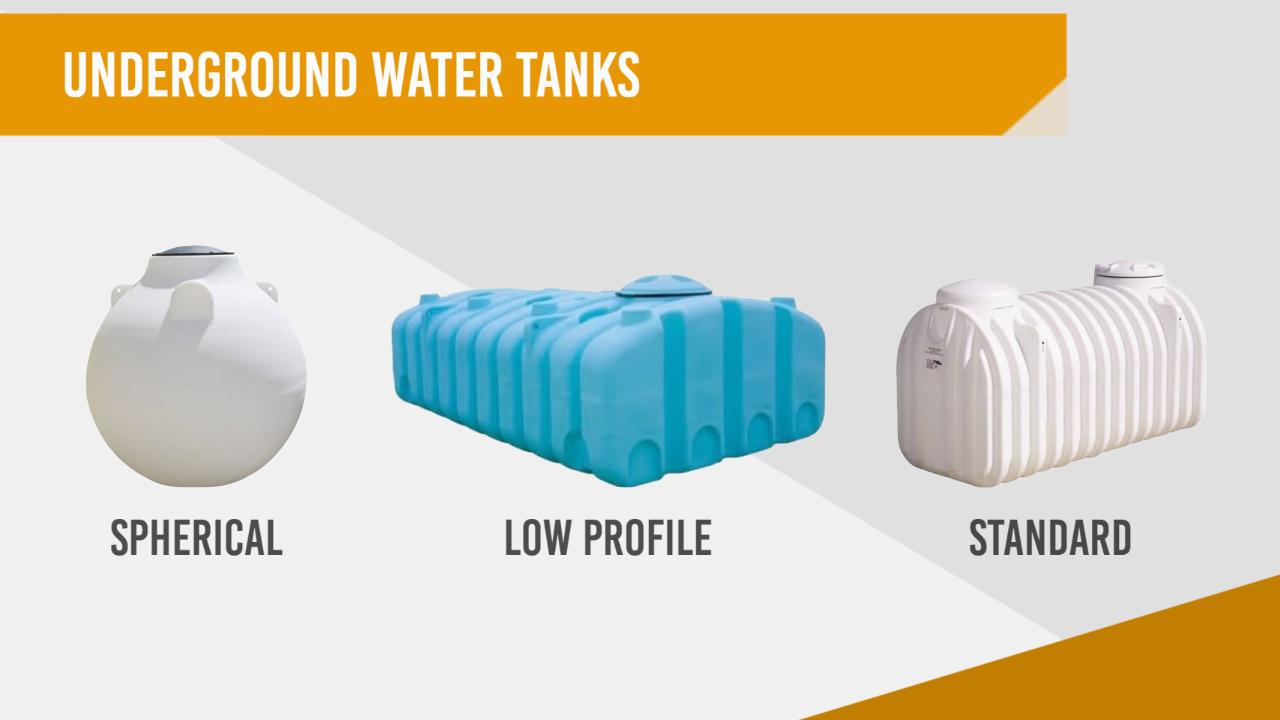
Design and Benefits
Underground water tanks provide unique benefits among the available water tank types for long term water storage. Cisterns protect the water stored inside the tank from the environment, the elements, from pest infestations, and algae growth. Being installed underground, cisterns keep the stored water away from sunlight and ambient air temperature changes. This provides stable water temperatures and without sunlight reaching the tank or water, it is impossible for algae to grow.
Cisterns are also protected from accidental damage such as tree falls, vehicle impacts, and fires. However, the area where the cistern is installed should never be driven over by vehicles or equipment as it can crack and ruin the tank.
Feature Options
Underground water tanks feature what are called fitting flats. Fitting flats are smoothed, flat areas on the tank wall that allow easy, secure installation of bulkhead fittings for making plumbing connections to piping and water pumps. Many are designed to accept up to 3 inch plumbing connections, some 4 inches, while others can accept larger connections depending on the cistern size and size of the fitting flats.
Fitting flats are often sized larger than the connections they are suitable for. This is intentional to ensure the integrity of the tank is maintained.
Most underground water tanks are not manufactured with inlet and outlet fittings already installed on the product and require these plumbing connections to be added when ordering the tank or personally by the owner after delivery and receipt.
Important Notes
The underground cistern tank model is not intended for aboveground installation and use. Underground water tanks differ from other water tank types in that they are built with thicker tank walls and/or are engineered with internal structural supports and a rugged, ribbed frame that increases the strength of the tank to withstand the pressure and weight put on the tank when buried.
Rainwater Collection Tanks
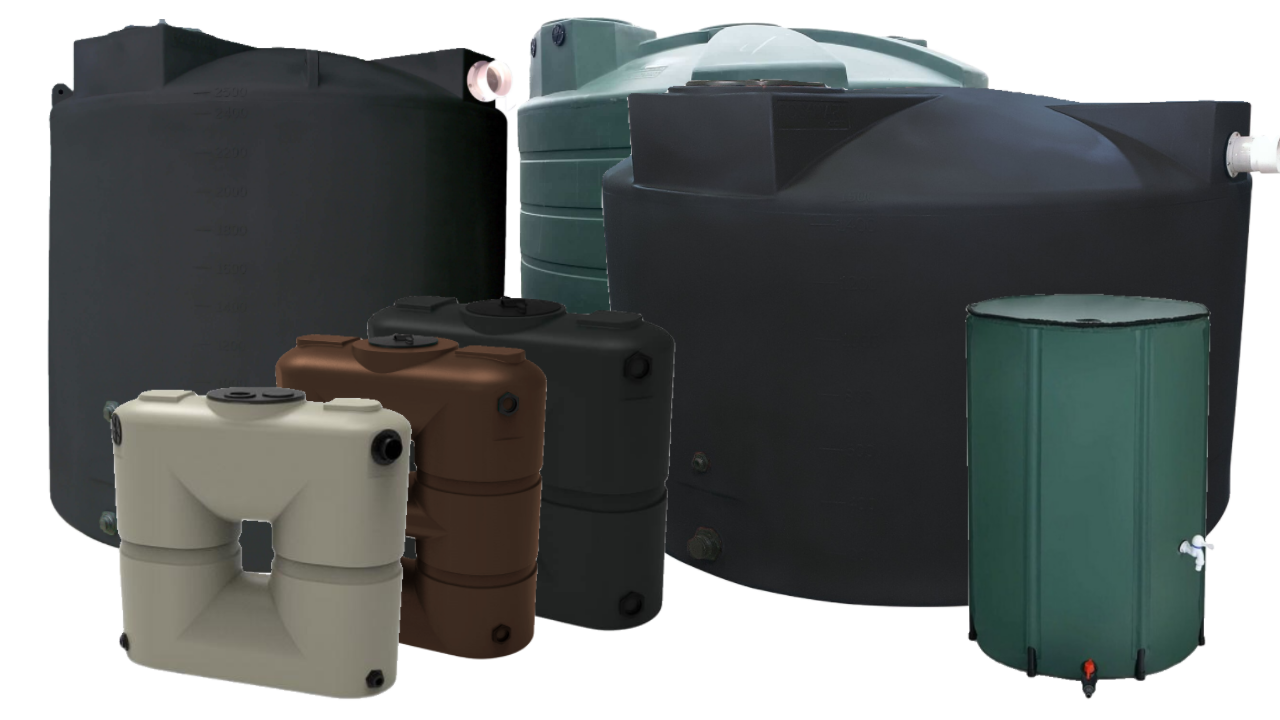
Rainwater collection tanks have storage capacities from 100 gallons up to 10,000 gallons. Purchase costs for rain tanks can range from $200+ to $4,800+ and will vary on volume, style, options, and manufacturer. Poly rainwater collection tanks include rain barrels, slimline rain tanks, and rainwater tanks.
Uses
Rainwater harvesting tanks are used to capture and collect precipitation so the water can be used when needed. Common rainwater uses include gardens, lawns, landscapes, livestock, cooling systems, water features, pools, and inside water needs not related to consumption such as flushing toilets and washing clothes. Domestic, inside home rainwater applications include for drinking, cooking, cleaning, showering, and washing dishes. However, prior to using a rainwater tank for consumption-based applications, the rainwater must be filtered, clean, and purified using a water treatment system or other suitable method.
We have an extensive, authoritative list of articles on rainwater harvesting practices, storage tanks, and accessories in our Rain Tanks Series posts.
Make and Color Options
Rainwater collection tanks are made from food grade high density polyethylene plastic approved for use with drinking water as a default standard. Therefore, they meet the requirements of the FDA, ANSI, and NSF. Rain tanks are available in black, green, blue, red, brown and various shades of these colors. Example color shades include dark green, light green, forest green, dark brown, mocha, tan, and beige.
Design and Benefits
Most rainwater containers are cylindrical in shape and include a manway with lid, an overflow kit, two or three preset fittings, and additional flat locations on the tank for installing extra fittings for plumbing connections.
The manway on many rainwater harvesting tanks also features an included tank screen accessory to catch debris such as leaves from rainwater as it flows into the container. This differs from vertical water tanks that do not include or need a manway screen.
Feature Options
Rainwater tank manway and lids are typically larger as the manway is often used as the point for collecting rainwater. Rainwater tank manway sizes range from 16 inches to 24 inches. Standard pre-plumbed fittings include outlet bulkheads from 3/4 inch to 1 inch and screened overflows either 3 inches or 4 inches in size. Rainwater tanks tend to have pre-installed fittings and often feature two outlets rather than only one for making connections to other rain tanks, additional system equipment such as water pumps, and to water pipes or hoses.
Doorway / Slimline Water Tanks
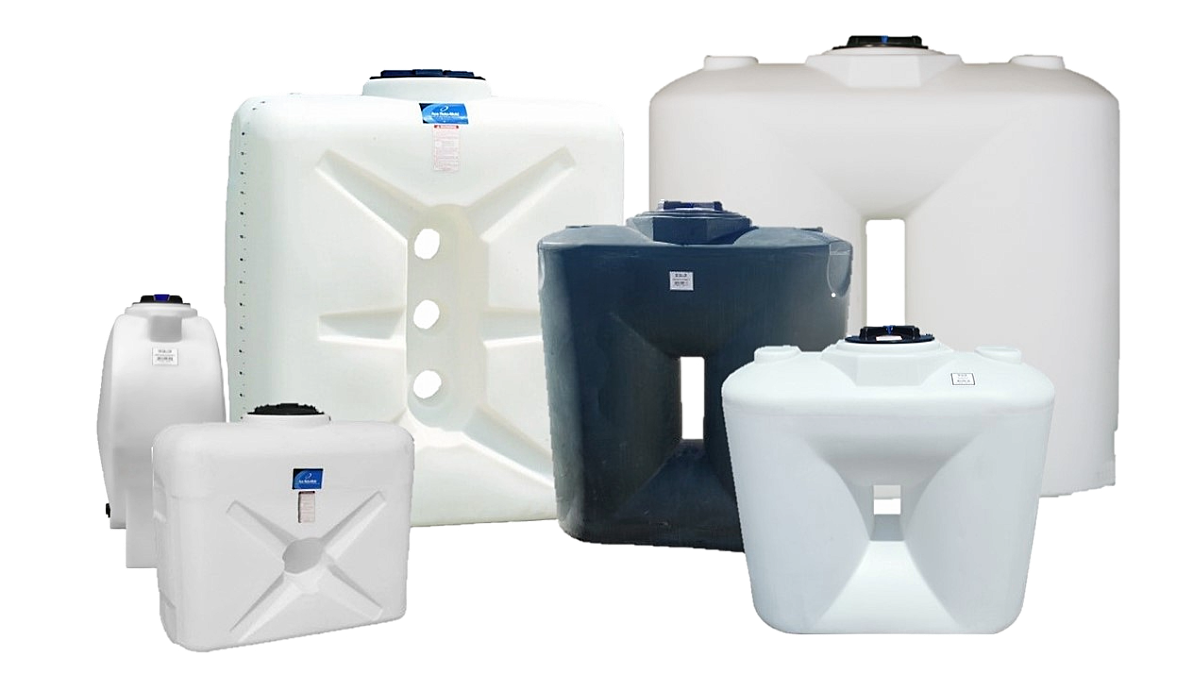
Doorway water tanks have storage capacities from 100 gallons up to 1000 gallons. Price ranges from $300+ to $2,100+. The unique design of doorway / slimline water tanks limits their maximum storage volumes due to engineering constraints and safety.
Uses
Doorway tanks are frequently used for personal home water storage, emergency water supply, rainwater harvesting applications, irrigation, gardening, emergency fire response, and sometimes as portable water tanks. Doorway tanks can also be used as a wall or barrier as a landscaping design and visual appeal.
Make and Color Options
Doorway water tanks are available in natural white, black, green, and freshwater blue in color. They are potable grade, ANSI/NSF Standard 61 certified for drinking water use.
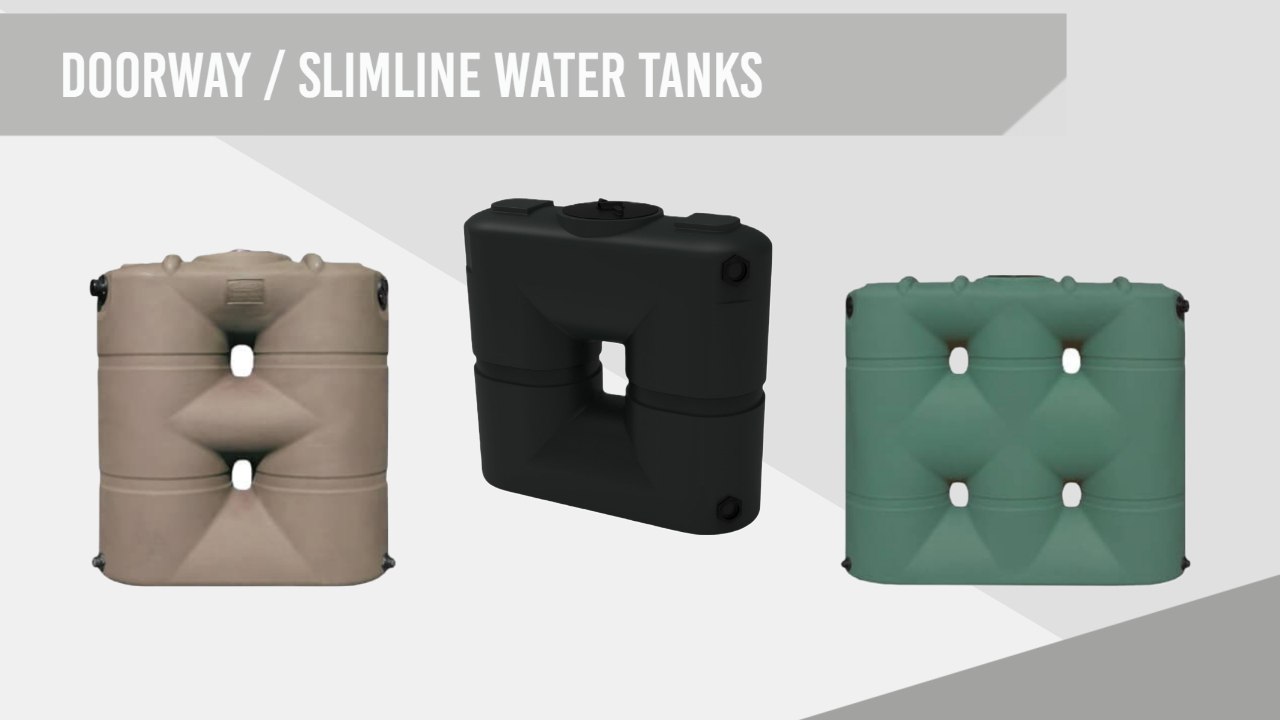
Design and Benefits
The doorway water tank, also known as a slimline tank, features a slender, thin profile that is square or rectangular in shape and vertical in build. This design helps the tank to fit better around properties, takes up less space, and is easier to transport, place, and install.
Their slim design and overall size allow the tanks to pass through doorways and inside structures such as garages, sheds, and barns. They are also commonly installed on patios, in gardens, along walkways, and along building walls. Businesses and municipalities will choose doorway tanks as the design makes the tank easier to fit alongside equipment on a vehicle for transport.
Most doorway tanks feature a hollow point in the middle as well as grooves along the tank sidewall surface. This design allows wind to pass through the tank rather than push on the tank, lowers the tank’s center of gravity for improved stability, and can also serve as an attachment point to anchor the tank if necessary such as in transport.
Feature Options
Doorway tanks feature slosh proof, self venting lids in 8 inch, 12 inch, and 16 inch sizes, with 16 inch manway lids being the most common. Available doorway tanks feature 2 to 4 fitting flat locations for making additional plumbing connections for rainwater harvesting, house utilities, hoses and sprayer systems, and connecting multiple tanks together. Doorway tanks often feature a single, polypropylene female NPT bulkhead fitting outlet available in 1-1/4, 1-1/2 or 2 inches in size.
Portable Water Tanks
Portable water tanks include several different tank types selectively engineered for improved portability, handling, and security in transport applications. The main tank types classified as portable water tanks include leg tanks, utility tanks, and IBC totes. Additional models include truck bed tanks and low profile transport tanks.
Leg Water Tanks
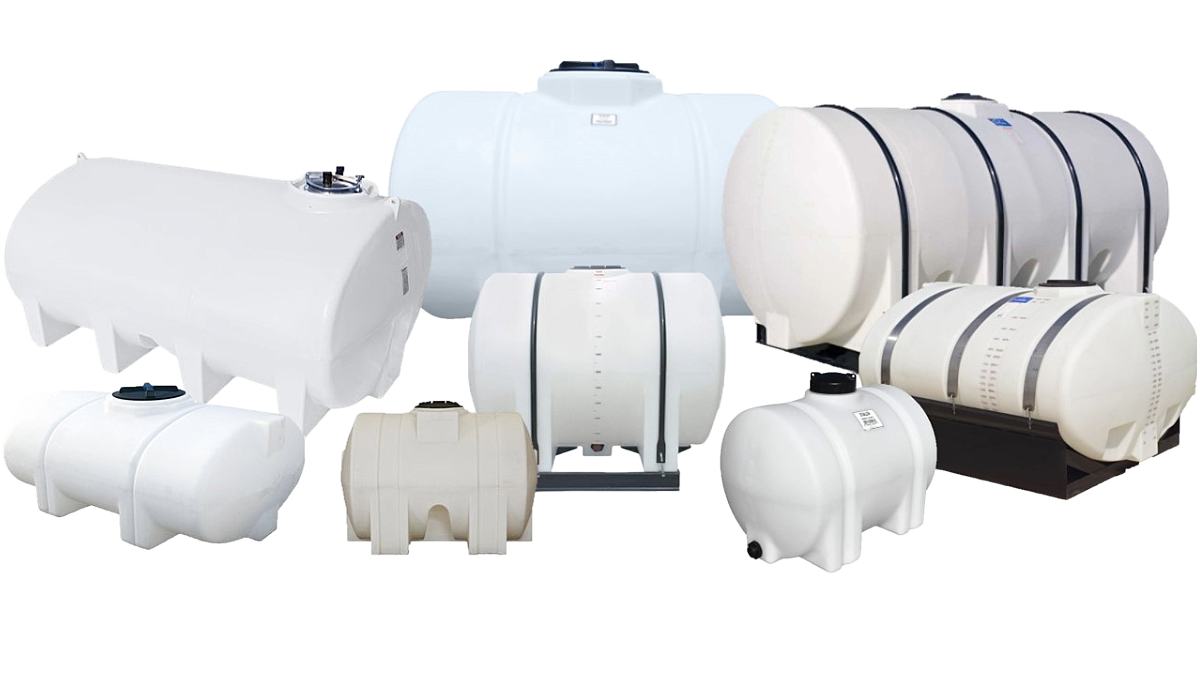
Leg water tank storage capacities range in size from 25 gallons up to 6025 gallons. Pricing can range from $100+ to $20,000+. The leg type water tank is manufactured in three different models: horizontal, elliptical, and elliptical cradle tanks.
Uses
Leg water tanks are a popular choice for water transport applications and are ideal for use from truck beds, pull-behind trailers, municipal vehicles, service trucks, and construction vehicles. Leg water tanks are often used in agriculture, construction, manufacturing, landscaping, lawn and grounds care, roadway maintenance, and dust suppression. The tanks are built to have a higher specific gravity rating, which provides greater structural strength to withstand the rigors of transport and allows them to be used with chemicals and mixture solutions.
Make and Color Options
This tank type is available in natural white, green, black, blue, and yellow. Leg tanks are available in either potable or yellow non-potable grade. Blue leg tanks are heavy duty models intended for high corrosive, high weight chemicals. Depending on the select style, leg tanks may require the additional purchase of steel support bands that help maintain tank stability in transport.
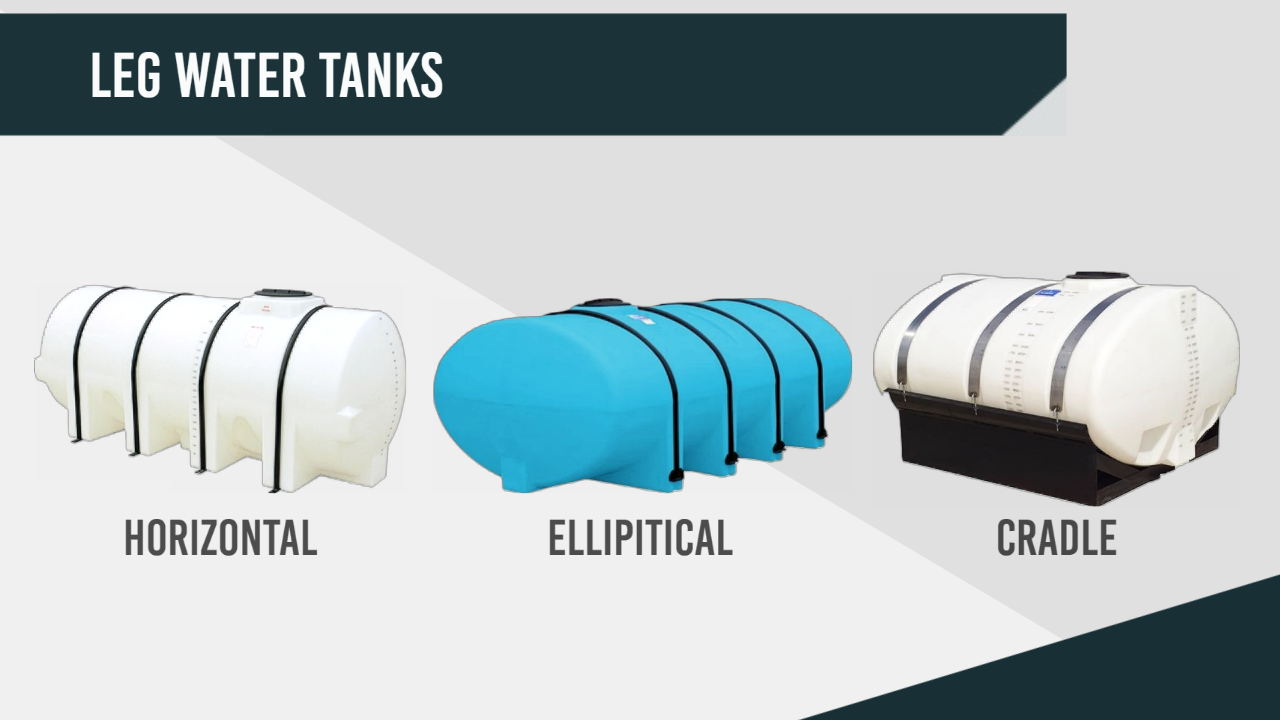
Design and Benefits
Leg water tanks are engineered with built in legs, the reason for their name. The legs function as stands to support the horizontal tank orientation and work as an internal baffle system to reduce water sloshing during transport. Most leg water tanks feature attachment groove straps molded into the tank wall exterior to allow use of additional support when the tank is being moved.
Elliptical leg tanks are oval in shape to lower the tank’s center of gravity and overall tank height, improving stability and driver rearview visibility during transport. Elliptical cradle tanks do not feature legs, instead they sit securely within a cradle-like frame that supports the tank and allows the tank to be lifted and moved by forklifts.
Feature Options
Leg tanks feature threaded, slosh proof, self-venting lids in size from 5 inches up to 16 inches. Outlet drain fittings are polypropylene NPT bulkheads with sizes ranging from 3/4 inch up to 3 inches for quick deployment and use with valves and plumbing. The 2 inch NPT bulkhead is the most common size. Sump models are available for some leg tank models with a built-in sump to promote full tank draining during use and cleaning.
Heavy duty models are available for leg tanks that feature a 1.9 specific gravity rating. The higher specific gravity rating increases the tank’s structural strength for use in water and chemical fluid applications.
Utility Water Tanks
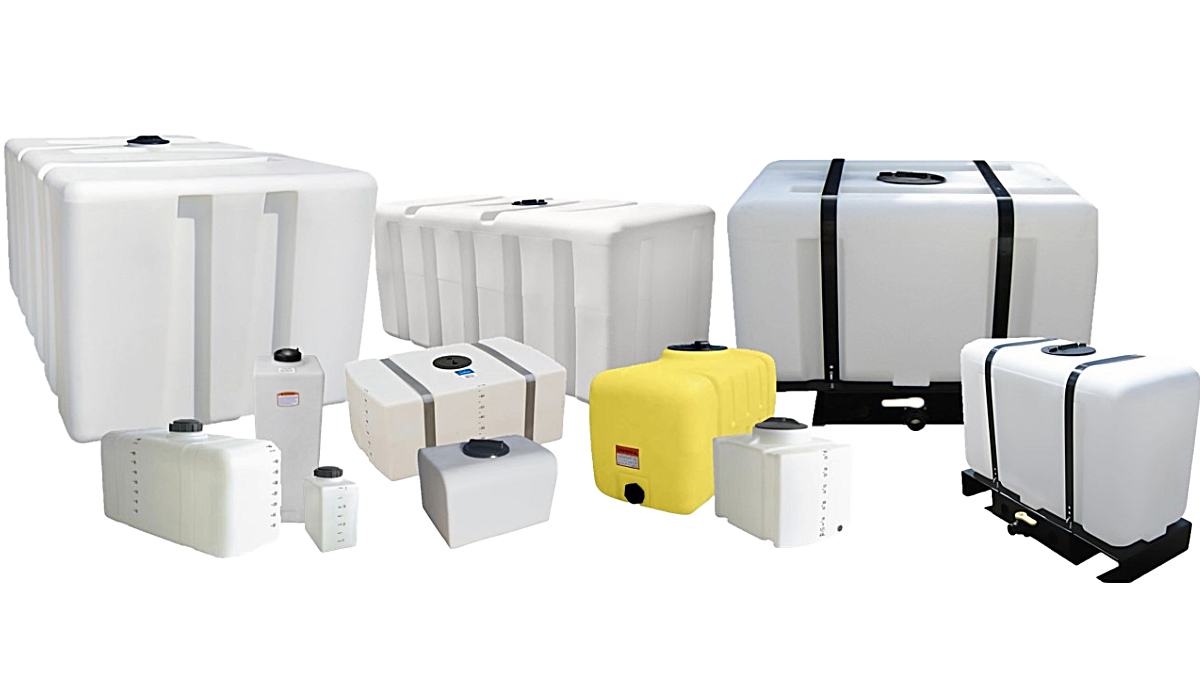
Utility water tank storage capacities range from 7 gallons up to 1050 gallons. Style options include utility tank, loaf tank, skid mounted utility tank, low profile, and ribbed utility tank. Pricing can range from $70+ to $3,000+. Heavy duty utility water tank models are available with a volume of 4200 gallons and a potential purchase price up to $8,000+ to $9,000+.
Uses
Poly utility water tanks are also known as portable tanks, transport tanks, pest control operator (PCO) tanks, detailing tanks, pressure wash tanks, sprayer tanks, and food truck tanks, indicating they are good for a wide range of applications.
Make and Color Options
Utility water tanks are available in black, white, and yellow colors. Tanks white and yellow in color are translucent, which makes it easier to see current water levels, but makes the tank more prone to algae growth. For utility tanks, white and black tanks are approved for drinking water uses. Yellow utility tanks are non-potable grade and often used in agriculture applications.
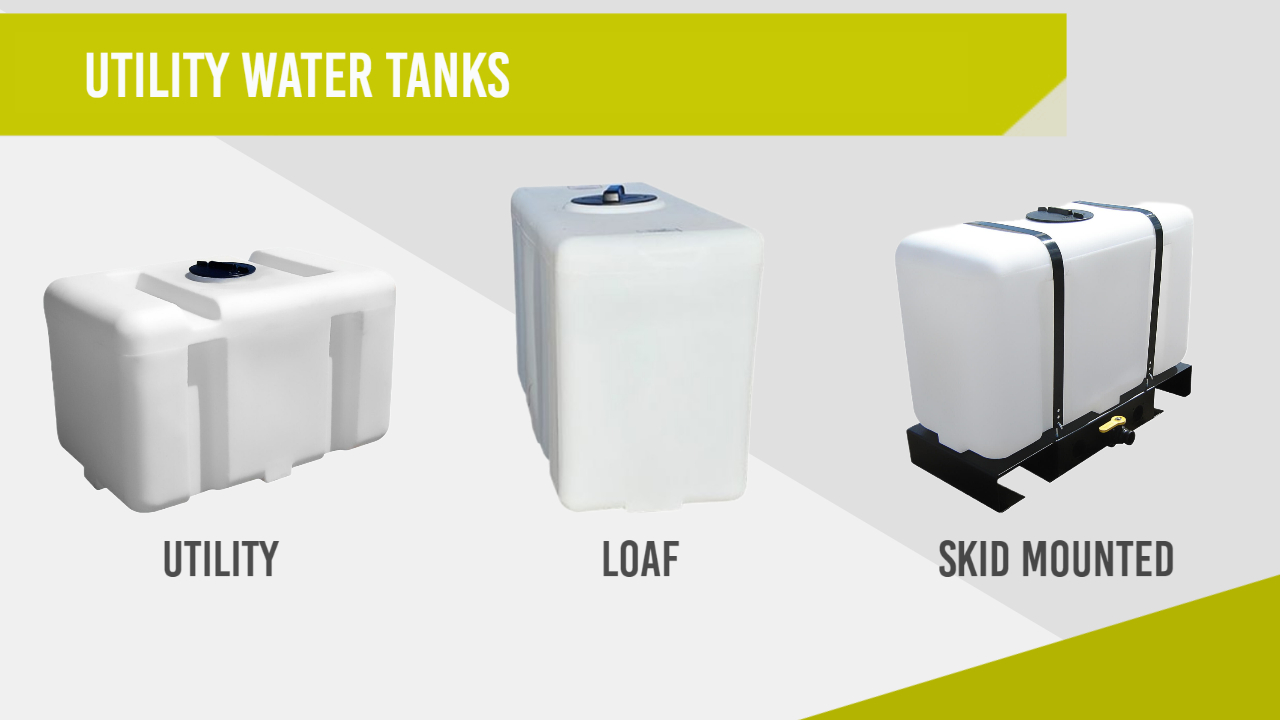
Design and Benefits
The utility water tank type has a flat bottom base and is free standing. The tanks are cubical in shape, improving their ability to be picked up, moved, and organized. Some utility tanks feature a built-in skid transport system that makes loading and unloading for transport quick and easy. Most utility tanks feature built-in grooves that allow the container to be secured in place through straps or support bands. Most products feature external gallon markings for monitoring current water levels inside the tank.
Feature Options
Lid options for utility water tanks range from 5 inches up to 8 inches and are leak resistant, self venting, twist-on, threaded screw caps. Utility tanks are often listed for sale without a pre-plumbed bulkhead fitting to allow the tank-owner to install the needed fitting size exactly where it’s needed. Some models feature fittings (skid mounted models), and utility tanks are available with the option to have fittings installed prior to shipping.
IBC Tote Water Tanks
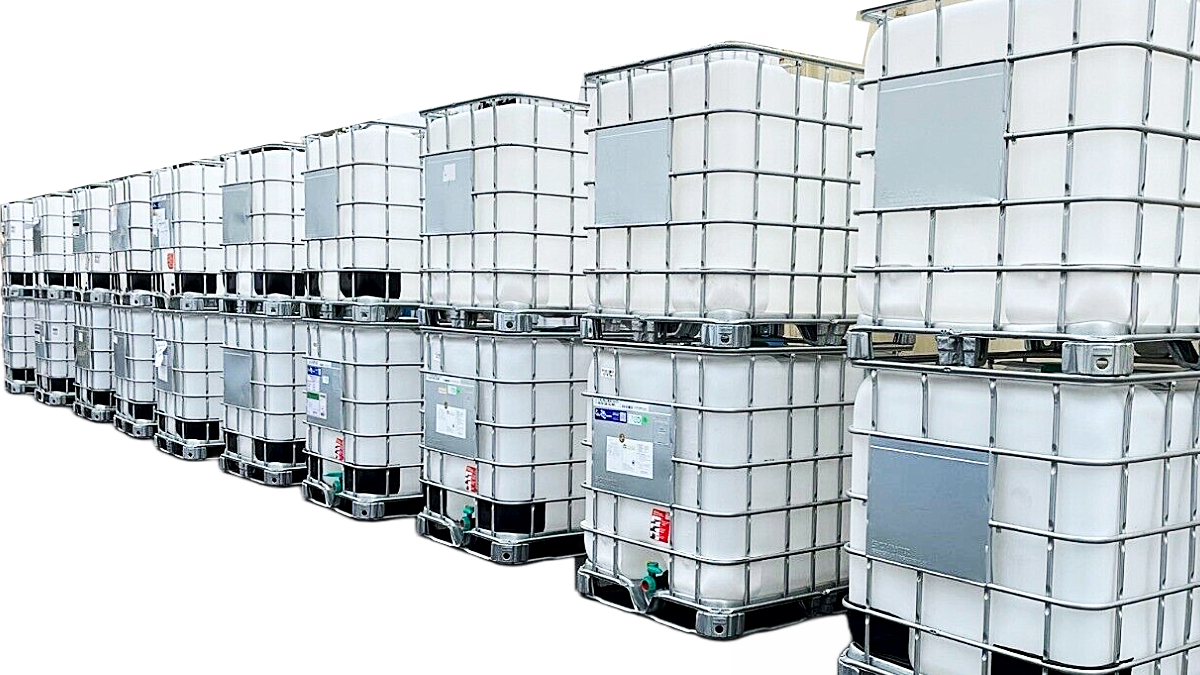
IBC totes (intermediate bulk containers) are available in several manufactured options suitable for water applications; however, the caged IBC tote is the best option and the model most often used in water type uses. IBC tote water tanks storage capacities range from 135 gallons up to 330 gallons. Prices can range from $190+ to $400+. The lowest IBC tote price is for the reconditioned caged IBC option. The highest price range is for new IBC tote tanks.
Uses
IBC totes are frequently used in agriculture, construction, landscaping, small businesses, large corporations, industrial facilities, mining, and municipalities as water tanks. Common residential uses for IBC totes include rainwater harvesting, aquaponics, gardening, and DIY projects such as planter boxes, firewood crates, and compost bins.
The IBC tote water tank, short for intermediate bulk container, is a well-known portable water tank option. The steel caged IBC tote in 275 gallon and 330 gallon volume capacity is the most popular and most used IBC tote style often known for being repurposed by DIYers. Note, the reconditioned caged IBC tote is not suitable for potable water applications.
Make Options
The poly caged IBC tote make and model is fairly standard across manufacturers. The totes feature an FDA approved polyethylene bottle, galvanized steel support frame, composite pallet base, and integrated ball valve.
IBC water tank types include:
Design and Benefits
Poly IBC water tanks are engineered with a built-in, pallet-like platform base designed to allow tote handling with either a pallet jack or forklift and significantly improves maneuverability. IBC totes are designed with a cubical, box-like shape and are considered to be lightweight. These features allow an IBC to be easily moved, positioned, organized, and squared up along walls, in corners, on trailers, around other objects as well as with other IBC totes.
Feature Options
Intermediate bulk containers come standard with a lid on top and an outlet valve on bottom. The outlet valve is located in a recessed cavity that protects against potential damage. IBC tote lid sizes are 8 inch vented, threaded twist cap lids. The standard outlet valve is a male NPT threaded, 2 inch ball valve. The outlet valve on caged IBC totes is designed for use with camlock quick connect couplers to allow fast connections to plumbing or conversion adapters for garden hoses.
Emergency Water Tanks
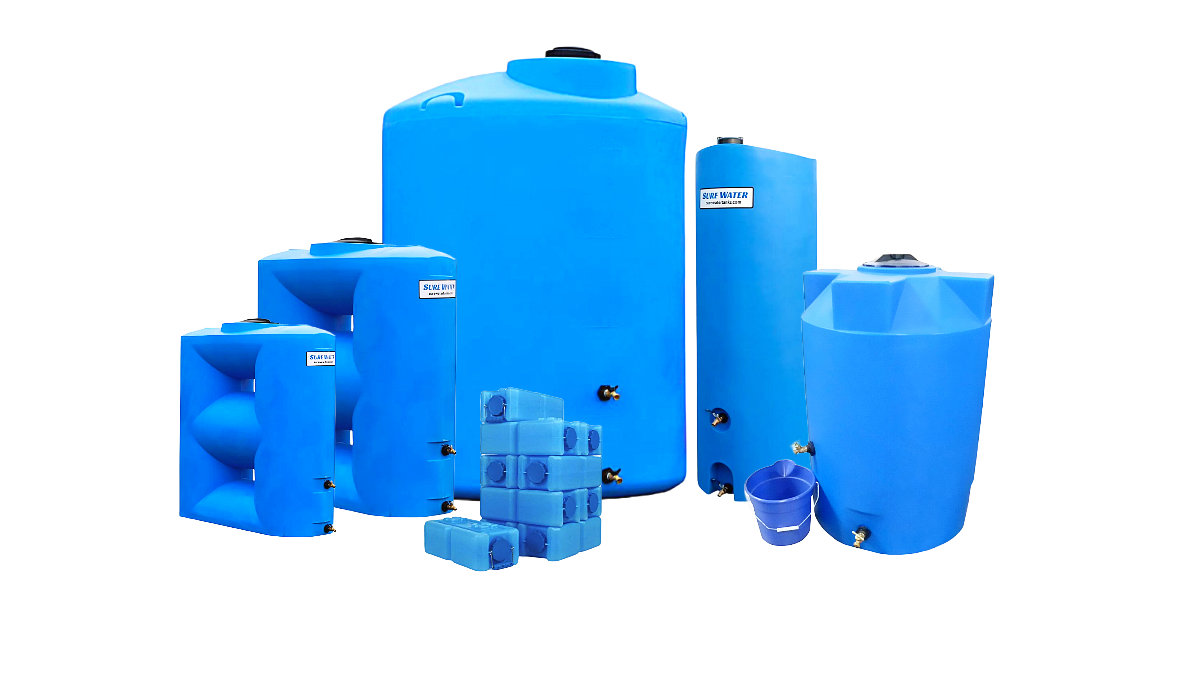
Emergency water tank storage capacities range from 100 gallons up to 500 gallons. Styles include cylindrical and doorway model emergency water tanks. Pricing ranges from $400+ to $1,100+.
Emergency water bricks are available with a smaller 3.5 gallon capacity and an interlocking, stackable design that allows better control and use of total water reserve volumes, transport, and space utilization. Water bricks are sold in ten (10) pack increments with pricing from $300+.
Uses
Emergency water tanks are solitary water tanks intended to store water for use during an emergency and disaster survival scenario when the main water supply source has been impacted and is no longer available or safe for use. Disaster examples emergency tanks can be used for include wildfires, earthquakes, snowstorms, hurricanes, severe droughts, and contaminated water supplies.
Emergency water tanks are largely intended for residential and rural use and are manufactured in specific volume ranges that make them easier to install the tank inside structures such as garages, basements, sheds, and barns.
Make and Color Options
Emergency water tanks are ANSI/NSF Standard 61 certified potable water tanks manufactured from FDA approved materials. These tanks are traditionally freshwater blue in color to increase the visibility of the tank and to serve as an indication of a safe, freshwater drinking source.
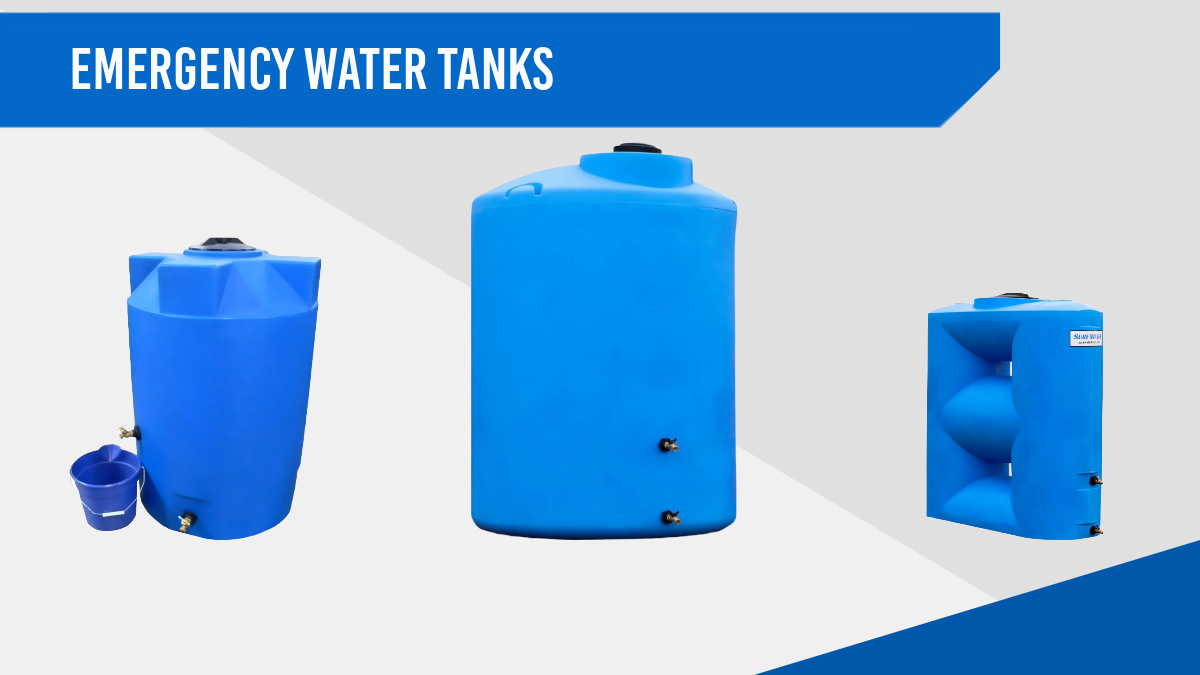
Design Feature Options and Benefits
Emergency water tanks often feature two, garden spigot style, 3/4 inch size brass outlet valves. One spigot valve is installed at height to allow easy filling of buckets and other containers. The second spigot valve is located at the tank base to allow full draining of the tank when cycling water or cleaning the container. Emergency water tanks feature an 8 inch to 16 inch tight-sealing, threaded manway with lid.
Other Water Tank Types
Other plastic water tank types available include cone bottom tanks, truck bed tanks, low profile transport tanks, stock tanks, open top tanks, RV water tanks, and marine vessel water tanks.
Cone Bottom Tanks
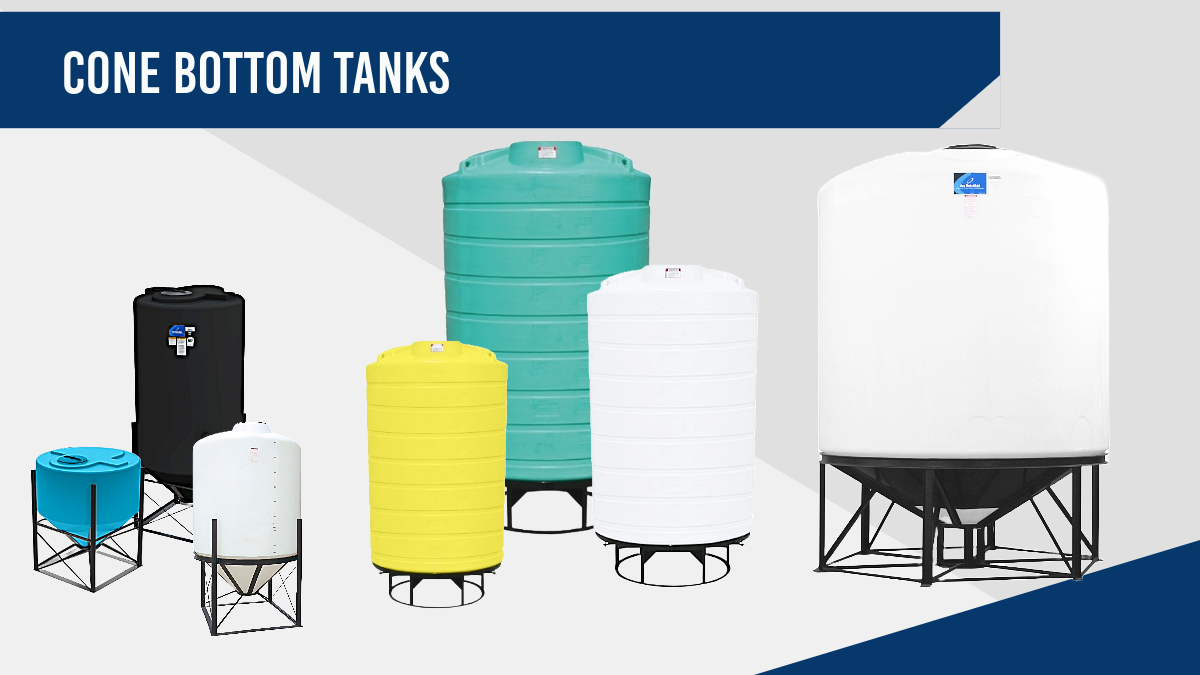
Cone bottom tanks are polyethylene water tanks with a conical shape and hopper-style bottom. This water tank model is engineered with a sloping base and central-located drain valve to facilitate complete discharge of the container’s liquid contents. Cone bottom tanks are often used in agriculture and for applications that require mixing, blending, or granulated contents. The cone bottom water tank model is available in storage capacities from 7 gallons to 12,500 gallons, different cone angle models, and with price ranging from $90+ to $16,000+.
Pickup Truck Bed Tanks
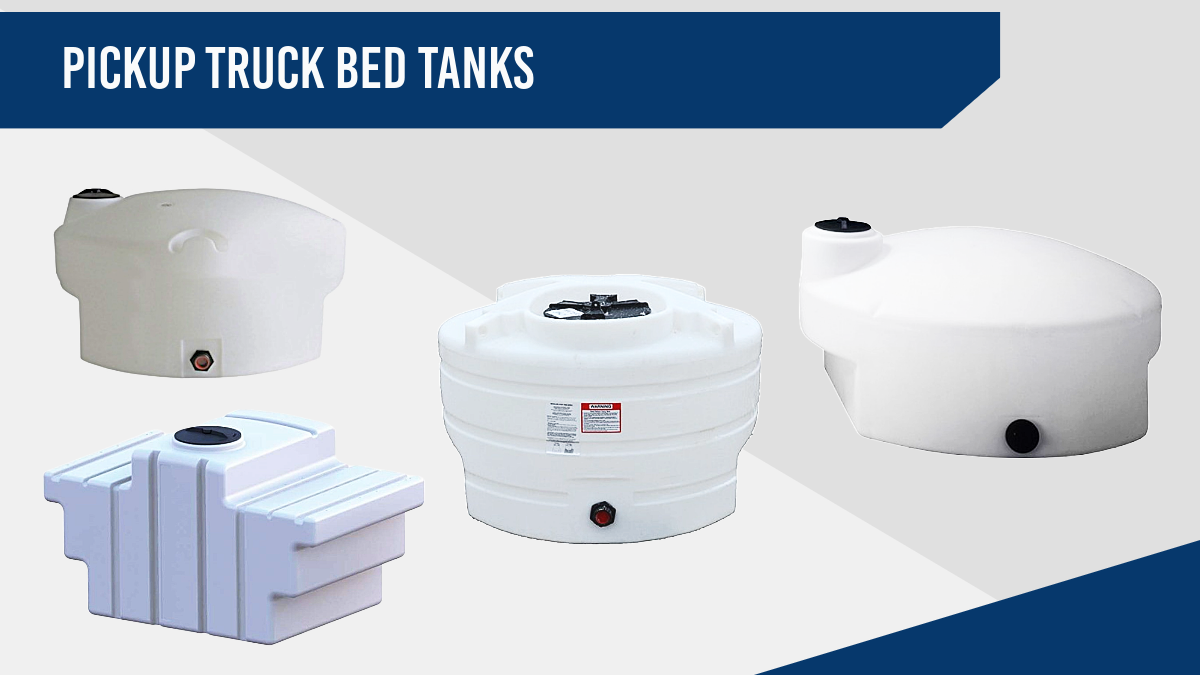
Pickup truck bed tanks are polyethylene storage containers designed exclusively to fit within, be transported, and used from the back bed of most standard sized, domestic pickup trucks. This water tank model often features a unique shape, an offset manway, and a pre-plumbed bulkhead fitting. The shape helps the tank fit more securely within truck beds. The offset manway improves owner-operator access to the tank for filling. The bulkhead fitting allows quick deployment through attaching a valve or plumbing such as a pump and sprayer to the tank. The pickup truck bed water tank model is available in storage capacities from 200 gallons to 450 gallons, with price ranging from $350+ to $1,000+.
Low Profile Transport Tanks
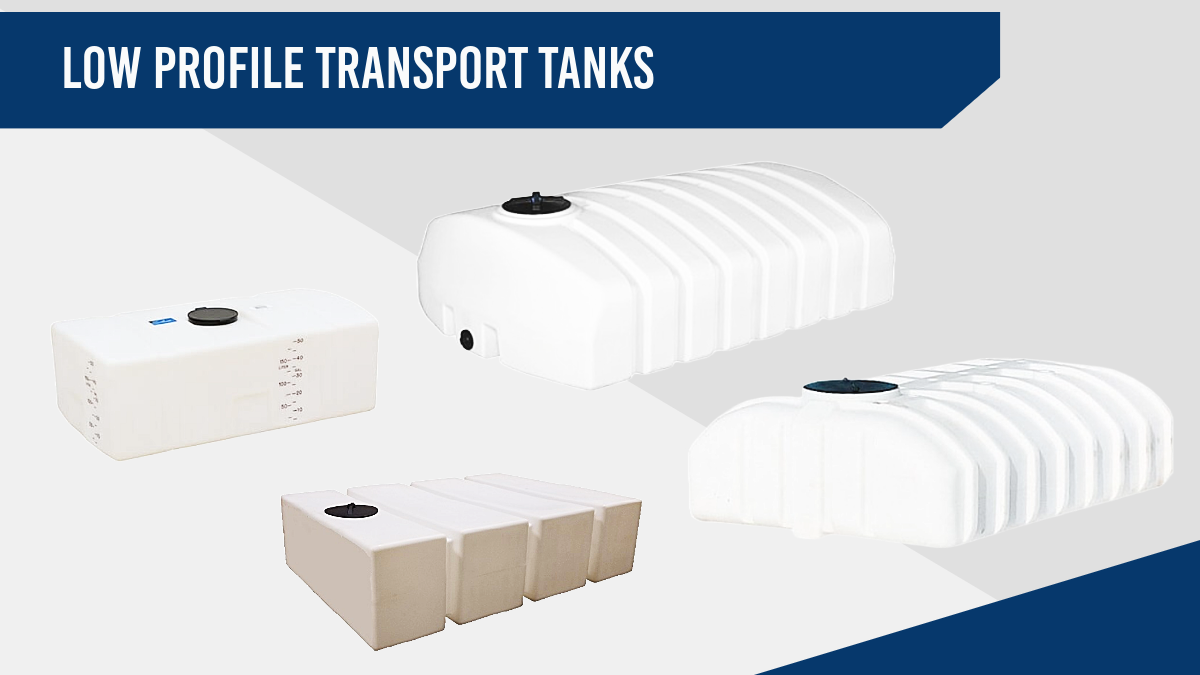
Low profile transport tanks are free-standing, poly-built containers with a flat bottom and reduced vertical height that makes them ideal for placement and transport in vehicles and on trailers. The reduced vertical height, i.e. low profile, improves an operator’s ability to see over the tank and lowers the tank’s center of gravity, both making the tank better for transport. This water tank model often features a manway with lid, a bulkhead fitting, and structural ridges. The structural ridges improve the container’s physical durability and provides a location for tiedown straps or support bands. The low profile transport water tank model is available in storage capacities from 50 gallons to 2,400 gallons, with price ranging from $250+ to $4,700+.
Stock Tanks
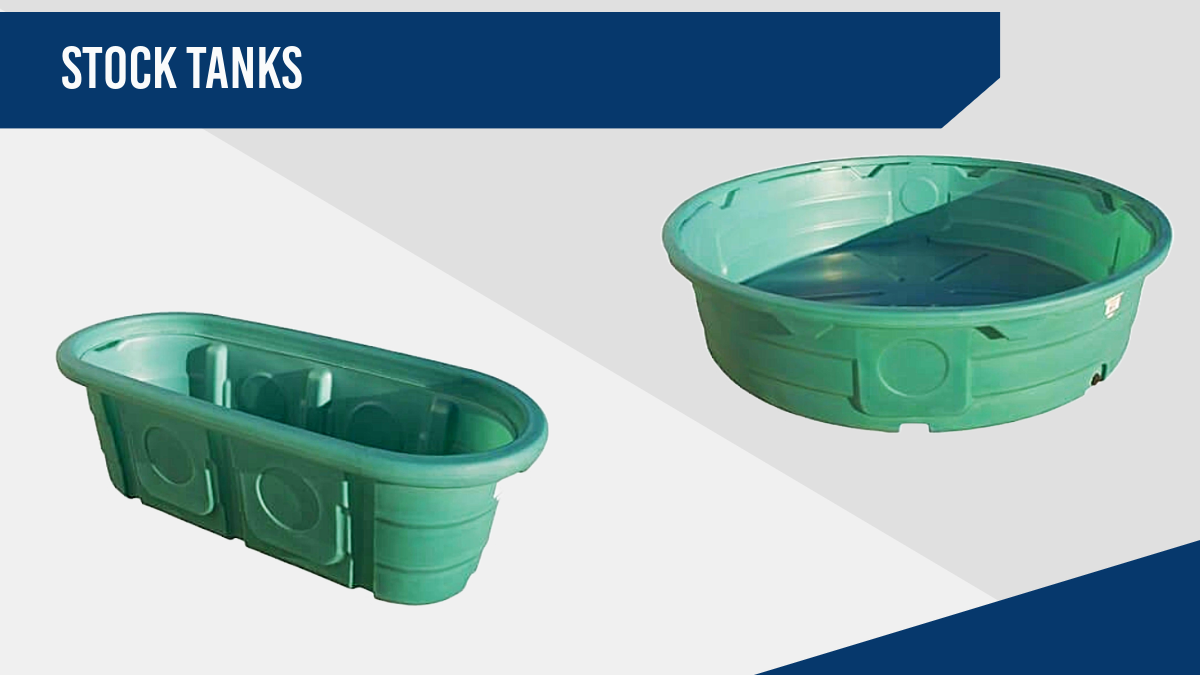
Stock tanks are polyethylene water basins most traditionally used as a watering trough for livestock and horses. This water tank model features an open top, the water reservoir, a rounded lip edge, and structural supports molded into the tank design. The rounded lip edge provides grip support for handling and smooths away rough edges to prevent accidental damage to animals should they bump the stock tank. The structural support ribs and ridges improve the tank’s physical strength. The stock tank water tank model is available in volume capacities from 50 gallons to 320 gallons with price ranging from $120+ to $350+.
Open Top Tanks
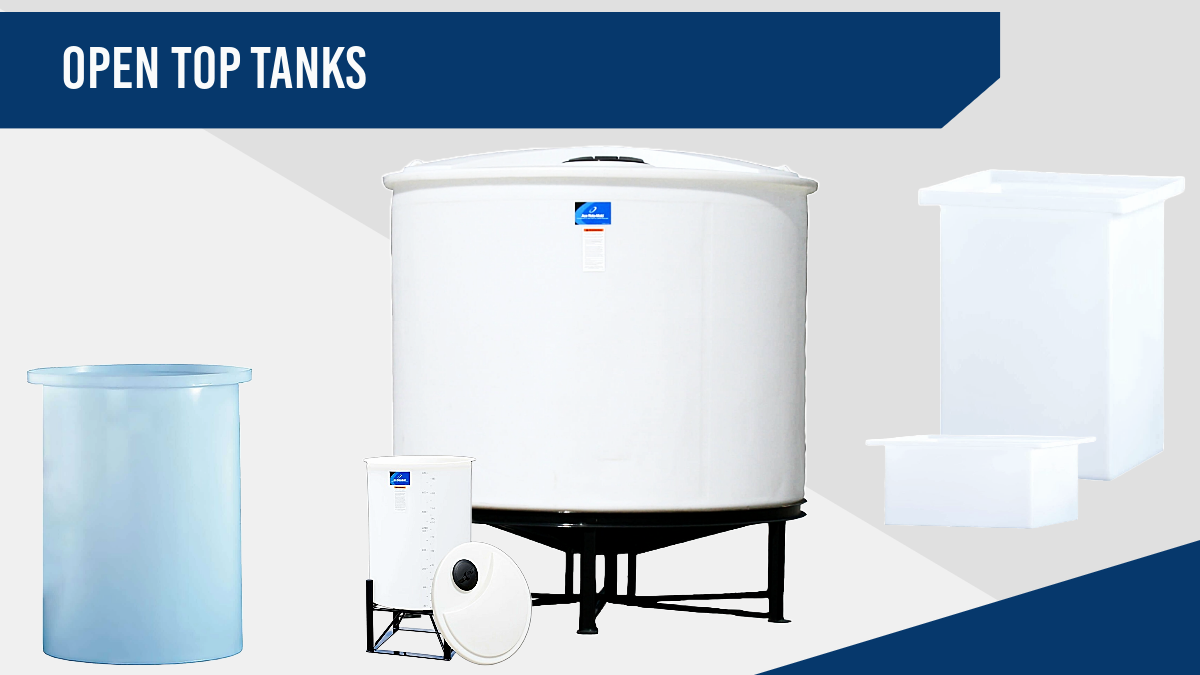
Open top tanks are plastic containers featured for sale without a lid or with a removable lid and therefore have an open top for tank access that is ideal for applications requiring blending, mixing, regular inspections, and/or cleaning. This tank model is available made from polyethylene or polypropylene plastic. Style options include cylindrical, square, and cone bottom open top tanks. The open top water tank model is available in storage capacities from 1 gallon to 6,800 gallons with price ranging from $30+ to $21,000+.
RV Water Tanks
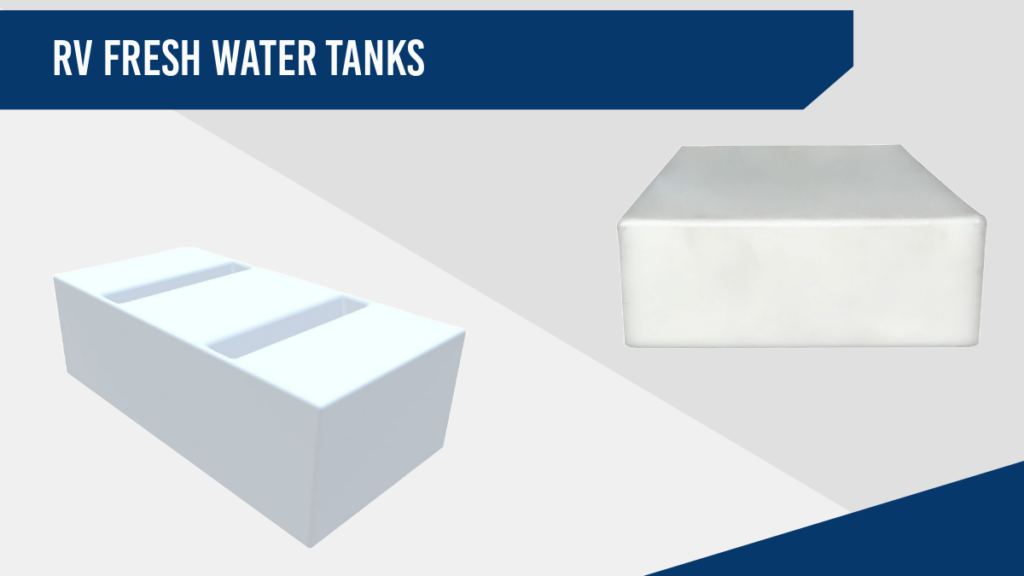
Recreational Vehicle (RV) water tanks are potable grade water holding tanks built in various shapes and sizes for use with modern RVs, campers, fifth wheels, and the like. Another common use for this water tank type is in tiny homes, job shacks, and remote, standalone buildings. This water tank type is most often provided as a “blank tank”, meaning without a lid or fittings, so the owner can install them precisely where they are needed for their installation or use. The RV fresh water tank model is available in storage volumes from 3 gallons to 260 gallons, with price ranging from $70+ to $1,300+.
Marine Vessel Water Tanks
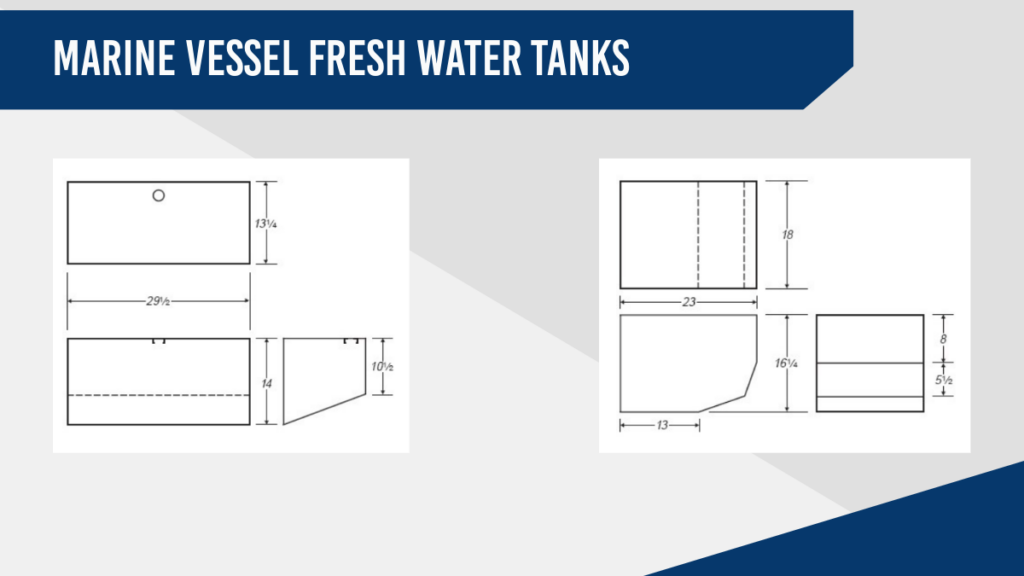
Marine vessel fresh water tanks are drinking water quality tanks, similar to RV tanks, built in a wide range of volumes, measurements, and shapes to fit modern, personal marine vessels and boats. This water tank model is traditionally provided as a “blank tank” without preinstalled fittings or a lid so they can be installed exactly where they are needed for the boat by the owner or a technician. The marine fresh water tank model is available in storage capacities from 3 gallons to 280 gallons, with price ranging from $130+ to $1,400+.
Takeaway | Guide to Poly Water Tank Types
In today’s product market, there are many poly water tank types to choose from. Each type has its selective uses they are best suited for, along with a unique design and accompanying range of engineering specifications that allows the water tank to be best-fit tailored to the needs of an application. The prices in this guide are provided for reference, as an insight for comparison, and are subject to change due to fluctuations in market valve, manufacturing, and raw material costs.
For more information on selecting the right water tank, see our companion Water Tank Buying Guide and our Water Tank Brochure.
For further questions on water tanks, help in product selection, or to request a custom tank, contact us, our professional and knowledgeable support experts are always ready to help. Consider our product catalogue search tool to search, filter, and find your perfect water tank today.

Professional Support
